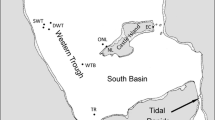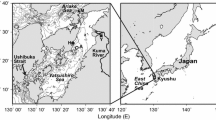Abstract
Environmental parameters that affect the growth ofChattonella antiqua were monitored throughout the outbreak period of this species around the Ie-shima Islands, the Seto Inland Sea, in the summer of 1987 (20 July–13 August). Averaged cell concentration ofC. antiqua over the water column (21 m) was below 10 cells· ml−1 on 20 July, gradually increased to reach the maximum of 250 cells·ml−1 on 7 August, and then rapidly decreased to the value of 30 cells·ml−1 on 13 August.
Thermal stratifications were prominent from 20 July to 3 August and were destroyed after 4 August. Temperature and salinity were optimum for the growth ofC. antiqua throughout the survey period.
At the bloom initiation period (20–21 July), concentrations of N- and P-nutrients (S N andS P ) were high throughout the water column. From 22 July to 3 August, whenC. antiqua increased its populations,S N andS P at the depth of 0–5m were low but those at the depth of 10–20m kept a high value. After 4 August,S n andS P at the depth of 10–20m decreased rapidly due to wind mixing coupled with the nutrient uptake byC. antiqua. When the populations ofC. antiqua reached the maximum (7–9 August), N-nutrients were depleted throughout the water column but P-nutrients were not. Concentrations of vitamin B12 were almost in the same range as those of the previous years and were optimum for the growth ofC. antiqua.
GP- value (growth potential of the seawater with respect to nitrogen and phos-phorus) was higher than 0.6 even at the surface layer (0–5 m) at the bloom-initiation period. During the bloom development period (22 July–3 August), GP at the surface layer (0–5m) was low (<0.2), but GP at the depth of 10–20m kept a rather high value (>0.4).In situ growth rates ofC. antiqua at the depth of 0 and 5m estimated from bottle experiments coincided well with the values expected from GP. A high value of GP at the surface layer in the initiation period and a shallow GP-cline in the development period, combined with the ability of diurnal vertical migration seemed to be at least one reason that natural populations ofC. antiqua grew at a rather high rate and formed red tides in the summer of 1987.
Similar content being viewed by others
References
Bandschneider, K. and R.J. Robinson (1952): A new spectrophotometric determination of nitrite in seawater. J. Mar. Res.,11, 87–96.
Fishery Agency, Japan (1988): Report on the red tide due toChattonella antiqua occurred in the eastern part of the Seto Inland Sea, Japan, in the summer of 1987. 79 pp.
Guillard, R.R.L. and J.H. Ryther (1962): Studies of marine planktonic diatoms. I.Cyclotella nana Hustedt andDetonula confervacea (Cleve) Gram. Can. J. Microbiol.,8, 229–239.
Hamamoto, S., S. Yoshimatsu and T. Yamada (1979): Diurnal vertical migration ofHornellia (Chattonella antiqua) in the field., p. 42–44.In: Reports on the red tides byHornellia occurred in June, 1978. Kagawa Prefecture, Japan (in Japanese).
Holmes, R.W., P.M. Williams and R.W. Eppley (1967): Red water in La Jolla Bay, 1964–1966. Limnol. Oceanogr.,12, 503–512.
Imai, I. and K. Itoh (1987): Annual life cycle ofChattonella spp., causative flagellates of noxious red tides in the Inland Sea of Japan. Mar. Biol.,94, 287–292.
Imai, I., K. Itoh and M. Anraku (1984): Distribution of dormant cells ofChattonella in Harima-Nada, eastern Seto Inland Sea, and temperature characteristics of germination. Bull. Plankton. Soc. Japan,31, 35–42.
MacDonald, R.W., F.A. McLaughlin and C.S. Wong (1986): The storage of reactive silicate samples by freezing. Limnol. Oceanogr.,31, 1139–1142.
Menzel, D.W. and N. Cowin (1965): The measurement of total phosphorus in seawater based on the liberation of organically bound fraction by persulfate digestion. Limnol. Oceanogr.,10, 280–282.
Murphy, J. and J.P. Riley (1962): A modified single-solution method for the determination of phosphate in natural waters. Anal. Chim. Acta.,27, 31–36.
Nakamura, Y., K. Sawai, M. Mochida and M. Watanabe (1987): An approach to estimate the limiting nutrient ofChattonella antiqua in the Seto Inland Sea—Semicontinuous culture using natural seawater. Res. Repts. Natl. Inst. Environ. Stud.,110, 197–212.
Nakamura, Y., J. Takashima and M. Watanabe (1988): Chemical environment for red tides due toChattonella antiqua. Part 1. Growth bioassay of the seawater and dependence of growth rate on nutrient concentrations. J. Oceanogr. Soc. Japan,44, 113–124.
Nakamura, Y. and M.M. Watanabe (1983a): Growth characteristics ofChattonella antiqua (Raphidophyceae) Part 1. Effects of temperature, salinity, light intensity and pH on growth. J. Oceanogr. Soc. Japan,39, 110–114.
Nakamura, Y. and M.M. Watanabe (1983b): Growth characteristics ofChattonella antiqua Part 2. Effects of nutrients on growth. J. Oceanogr. Soc. Japan,39, 151–155.
Ono, C. and H. Takano (1980):Chattonella antiqua (Hada) comb. nov., and its occurrence on the Japanese coast. Bull. Tokai Reg. Fish. Res. Lab.,102, 93–100.
Solórzano, L. (1969): Determination of ammonia in natural waters by the phenolhypochlorite method. Limnol. Oceanogr.,14, 799–801.
Strickland, J.D.H. and T.R. Parsons (1968): Determination of silicate in seawater.In: A Practical Handbook of Seawater Analysis. pp. 311. Fish. Res. Bd. Can., Ottawa.
Wood, E.P., F.A. Armstrong and F.A. Richards (1967): Determination of nitrate in seawater by cadmium-copper reduction to nitrite. J. Mar. Biol. Assoc. U.K.,47, 23–31.
Yentsch, C.S. and D. Menzel (1963): A method for the determination of plankton chlorophyll and phaeophytin by fluorescence. Deep-Sea Res.,10, 221–231.
Author information
Authors and Affiliations
Rights and permissions
About this article
Cite this article
Nakamura, Y., Umemori, T. & Watanabe, M. Chemical environment for red tides due toChattonella antiqua . Journal of the Oceanographical Society of Japan 45, 116–128 (1989). https://doi.org/10.1007/BF02108885
Received:
Revised:
Accepted:
Issue Date:
DOI: https://doi.org/10.1007/BF02108885




